Embracing the crisp air, the crunch of snow underfoot, and the snug warmth of your baby bundled close creates unforgettable moments that bond you even closer when you’re hiking with your baby. Today, St. Louis mom of four, Steph Hampton, is here to share her tips, advice, and recommendations for winter hiking with a newborn. Whether you’re a seasoned outdoors enthusiast or a newbie to the trails, Steph offers encouragement, support, and a dash of inspiration to embark on this magical adventure with confidence. Taking your newborn out for their first time hiking in the winter can be a memorable and magical experience for both of you. So, get ready, and let’s hit the snowy trails together!
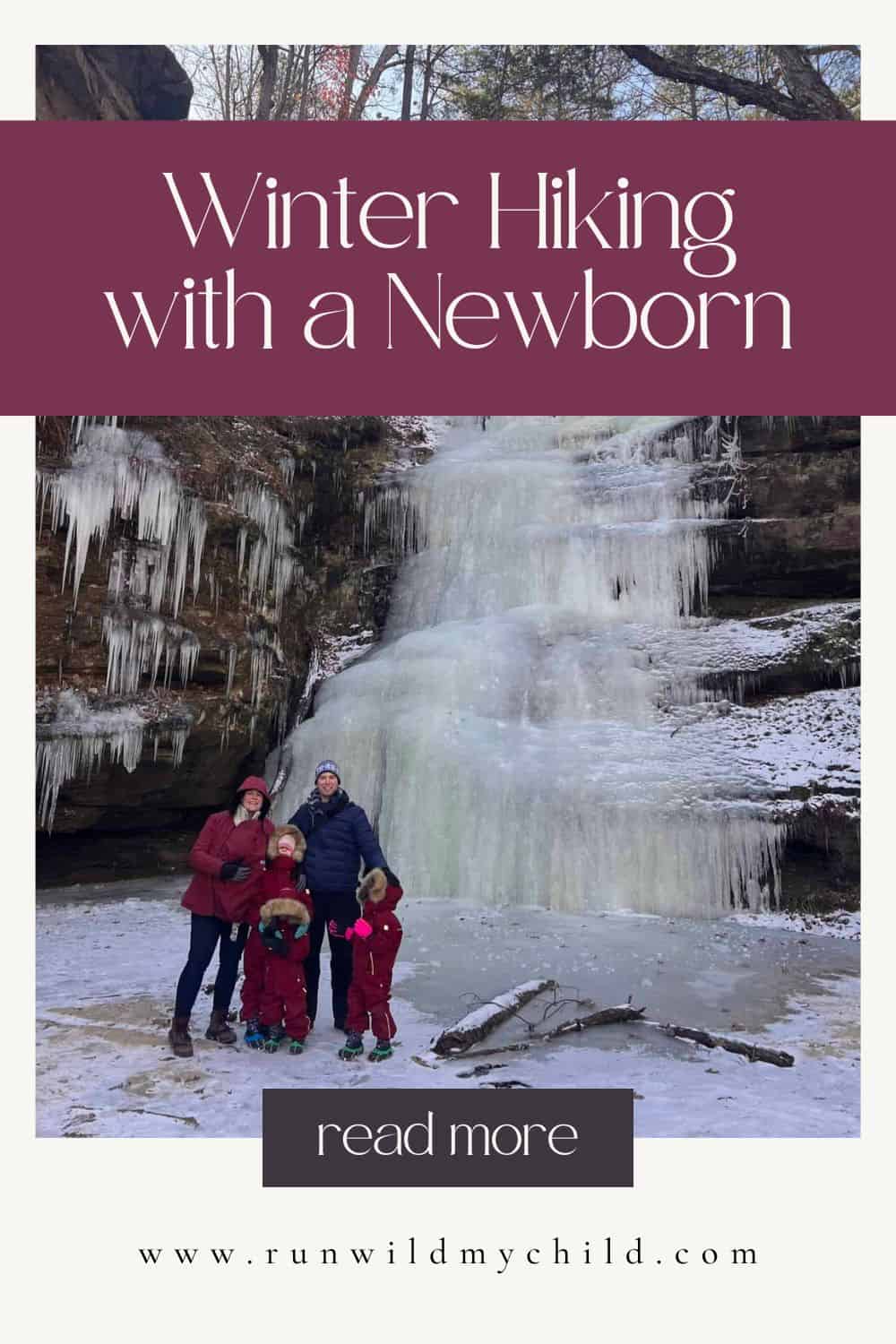
Winter hiking with a newborn
What’s better than winter hiking? Winter hiking with a newborn, of course!! Okay, maybe not the most ideal conditions with a baby, but it can be done!! And it can be safe and peaceful, too.
My first three daughters were all born in the late spring/summer, so it seemed like a whole new ball game when our fourth daughter, Maria, arrived this winter. With a winter baby, I couldn’t take Maria on a walk as seamlessly as I could my other newborns because of the cold conditions. We live in St. Louis, Missouri, which means the weather could be warm one day, and then the next, an ice storm hits, and the whole city is shut down for the day!
However, I believe in the importance of still exploring outdoors in all weather, so getting outside with our newest edition (even on cold days) was a must. I wanted to make sure there were steps to ensure Maria’s safety, though. Below are a few tips and tricks that worked well for us to help us get outside with a newborn baby and explore together as a family in winter.
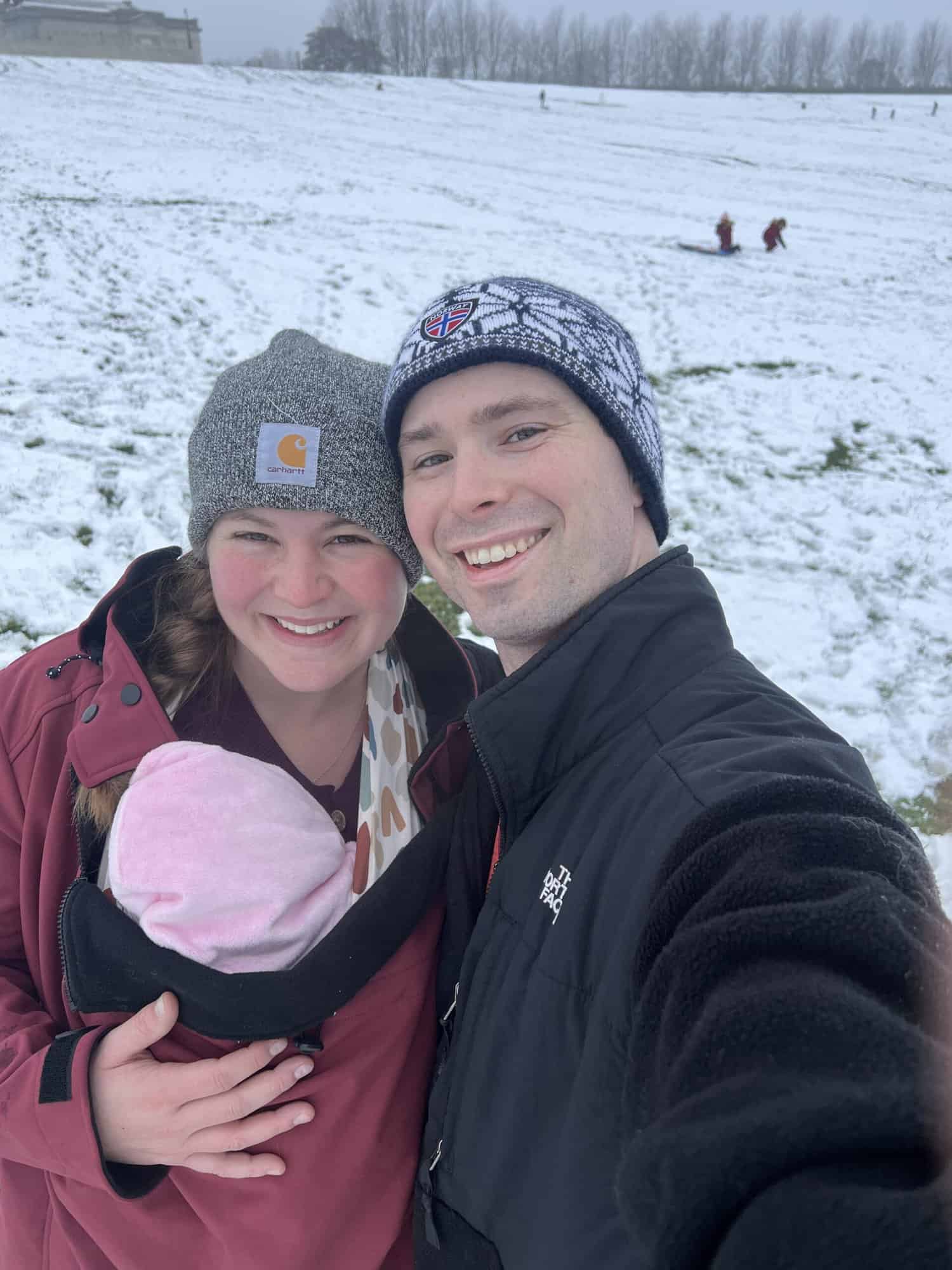
Why hike in the winter with a newborn
Hiking during the winter with a newborn offers so many benefits for both moms and their little ones. First, it’s a great way for moms to escape the confines of indoor spaces (I think we probably all get a bit stir crazy in the winter) and immerse themselves in the beauty of the natural world. Winter landscapes, with their glistening snow-covered trails and frost-kissed trees, offer gorgeous scenery for bonding with your baby. The crisp, fresh air and sunshine (when it’s out) can be really rejuvenating.
Winter hiking with newborns promotes physical activity and outdoor exploration from an early age, laying the groundwork for a lifetime of healthy habits and appreciation for nature. For moms, the moderate exercise of hiking can help improve cardiovascular health, boost mood and energy levels, and facilitate postpartum recovery.
For babies, the gentle rocking motion of hiking can soothe infants and lull them to sleep, creating a peaceful and intimate environment for bonding between mom and baby. Additionally, the sensory stimulation provided by the sights, sounds, and textures of the natural environment can stimulate cognitive development and sensory awareness in newborns, fostering curiosity and engagement with the world around them.
Overall, winter hiking with newborn babies offers a unique and rewarding experience that promotes both mom and baby’s physical, emotional, and developmental well-being.
Tip 1: Always check the weather and trail conditions
Check your local weather app before hiking a winter trail. I always check for the ice/snow possibilities for safety when driving to and hiking on the trail. Checking the weather conditions and trail conditions before heading out for a winter hike with a baby is not just a precautionary measure; it’s a necessity to ensure the safety and comfort of both you and your little one.
I also always check the All Trails app (a free resource where people rate hikes for the latest trail conditions). Hikers post their reviews on the trail conditions. I find this very helpful, in addition to sometimes calling the nature center or visitor’s center associated with the park to ask about trail conditions. Understanding the trail conditions, including terrain, elevation, and potential hazards like ice or snowdrifts, allows you to choose a route that is suitable for your fitness level and your baby’s needs, ensuring a smoother and more enjoyable hiking experience.
When we arrive at the trail, we go with our gut if something appears unsafe. Nothing is more important than your family’s and your health and safety!
Winter weather can be notoriously unpredictable, with sudden changes in temperature, wind, and precipitation. By staying informed about the forecast, you can be prepared by making sure you’re dressed in appropriate layers, have extra supplies, and can adjust your route if necessary.

Tip 2: Dress appropriately (layers)
Have you heard the phrase, “There is no such thing as bad weather, just bad clothing?” That phrase speaks well for getting outside in winter conditions. Choosing the right gear and dressing appropriately in layers are paramount when it comes to winter hiking, especially when you’re bringing along your little one.
When winter hiking with a newborn, you’ll want to be sure to dress yourself and your baby in layers to regulate body temperature. Layers really do make all the difference here. Depending on what the kids and I are wearing, our clothing can sometimes predict how long we can explore safely outside. Finding comfortable hats, gloves, boots, snow gear, etc. is crucial.
We wear three layers: base layer (wool), mid layer (fleece), and outer layer (snowsuit/jacket). There is peace of mind knowing that we can safely be outside in all types of weather.
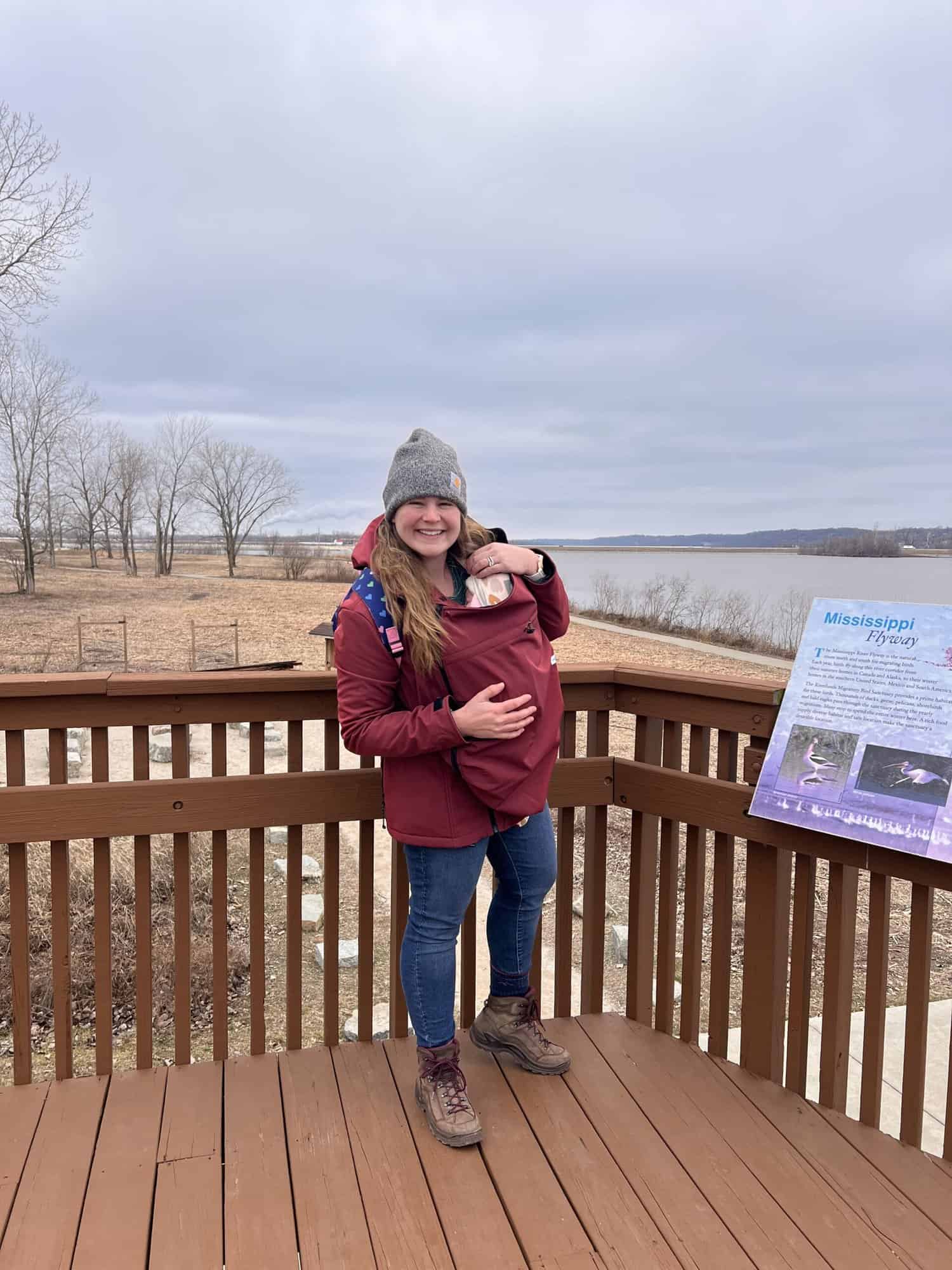
Dressing a baby for winter hiking
For both mom and baby, investing in high-quality clothing made from materials like merino wool can make all the difference. Merino wool offers exceptional warmth, moisture-wicking properties, and breathability, ensuring comfort throughout the hike. Our favorite brand, Nui Organics, exemplifies these qualities with their range of merino wool garments tailored for both adults and children. From cozy base layers to insulating mid-layers and outerwear, Nui Organics provides durable and sustainable options that keep the whole family warm and dry on the trail.
For additional info on merino wool (and whether it’s worth the investment), check out our full post on the best merino wool brands for kids.
When we arrive at a trailhead, the first thing I do is change Maria’s diaper and nurse her in the warm car in the parking lot. She is usually already wearing her base layer with long sleeves, so next, I put on her mid and outer layers. For Maria’s base layer, I adore Nui Organics merino wool onesie. It is hard to locate merino wool base layers for newborns and I’m extremely happy with their soft and great quality!
Next, I dress her in fleece pajamas for her mid-layer. (I have some from Carter’s, but any fleece PJs will do!) Then, I put on Maria’s moccasins (lambskin booties from Nui Organics), which keep her feet and toes nice, warm, and protected.
If the weather is below freezing, I also like to put on her snowsuit as an outer layer. I complete the trail fashion look by wrapping her up in my Wanderling babywearing jacket! Ensuring your baby is bundled up in warm layers sets the stage for a successful hike, even on the coldest of days.
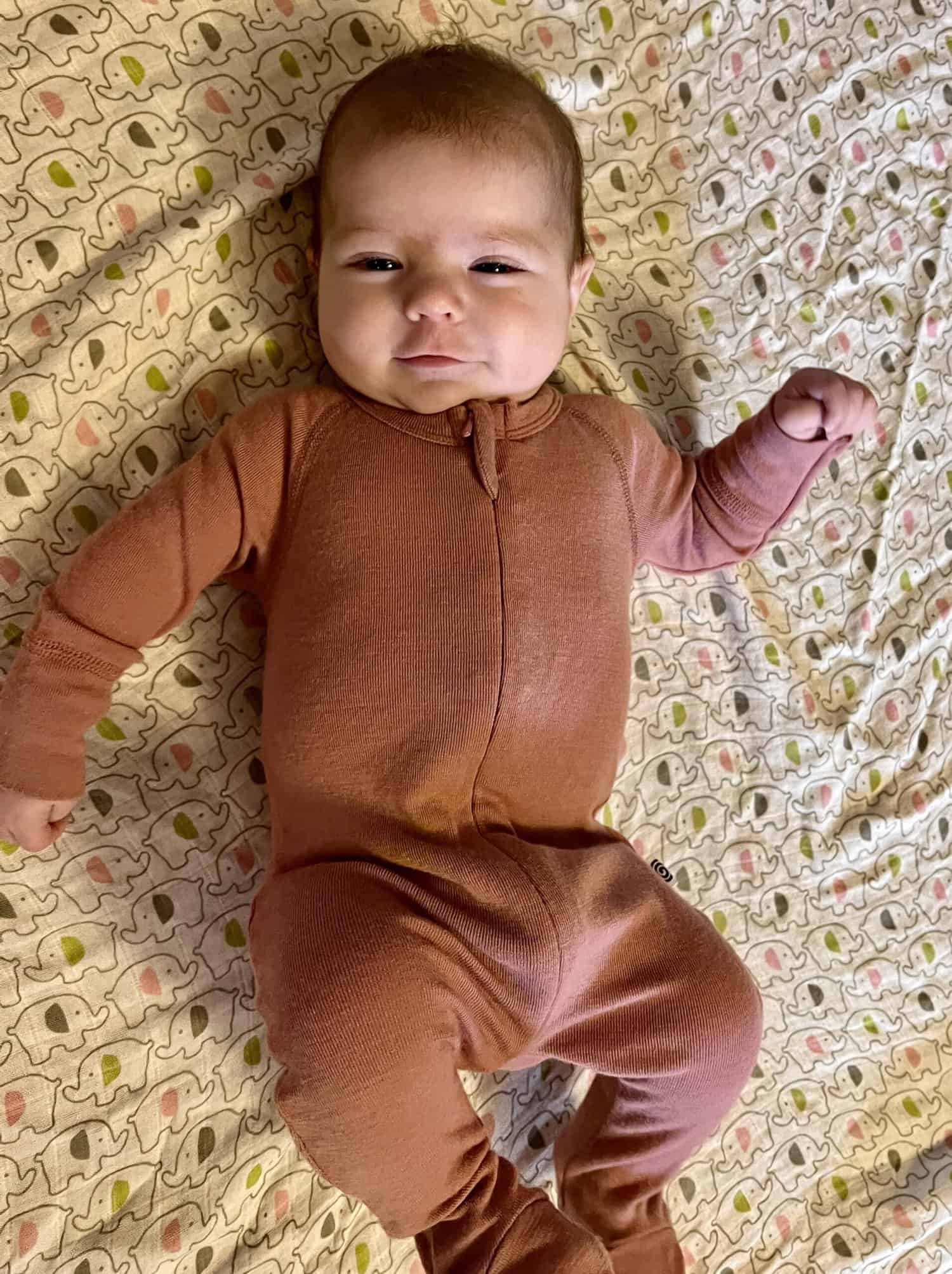
How to dress little kids for winter hiking
When dressing my older girls, again, layering is key to regulating body temperature and adapting to changing weather conditions during winter hikes. The older girls are moving around a lot more than a newborn, so being able to add/remove layers is key. You can always add an extra layer if they get cold, or take something off if they get warm. Also, having waterproof and windproof layers are important, because they’re less protected than the baby, next to me, under my jacket.
Start with a moisture-wicking base layer to keep sweat away from the skin, followed by an insulating mid-layer such as a merino wool sweater or fleece jacket. Finish with a waterproof and windproof outer layer to shield against the elements. I dress my older girls (ages 2, 4, and 6) in Reima gear. They are a Finnish company that is fantastic quality! The wool base layer set is Taitoa. Their mid-layer is a fleece Laskien sweater. Their outer layer is the waterproof Reimatec Stavanger snowsuit.
I also rub Aquaphor on their cheeks to prevent chapped skin and bring hand warmers along on the hike too.
For more information on winter gear, check out our full posts on the best winter gloves/mittens for kids and the best snow boots for kids.


Dressing mom for winter hiking
Don’t forget about mom! You’re the leader of the pack, so make sure that your gear and clothing choices are just as good as your kids. Oftentimes, it can be easy to overlook ourselves when dressing the kids, but the more comfortable you are outside, the longer you’ll be able to stay out there and keep up with them!
When hiking with a newborn, there are a couple extra considerations to take into account. Nursing my baby on the trail is one of my favorite things, so I have to make sure that I have layers and clothing that help me stay warm while nursing her and providing easy access for feedings.
For my base layer, I love Kojo’s nursing-friendly merino wool base layer! I wear my Wildelore fleece as my mid layer, which is also nursing-friendly! This fleece is very warm and I wear it as a jacket most days too. Last, I wear my Wanderling babywearing coat (which is so covers both of us). I like that this jacket has the option to wear Maria with a front carrier, a back carrier or wear without any baby attached. The attachable zipper panel is genius!
I also wear wool socks to keep my feet warm, waterproof hiking boots, and a wool hat.
Best baby carrier for winter hikes with a newborn
A baby carrier is a must-have accessory for winter hiking, keeping your little one snug and secure while you traverse snowy trails. I recommend a wrap or soft carrier for babies in the winter. Body heat is essential for keeping both mom and baby warm during winter hikes, so snuggling up close in the carrier is a cozy way to share warmth.
The Beluga baby wrap is my favorite when hiking with a newborn. Maria is so snug on me, and it helps keep her close to my body to warm her if it is very cold. I wrap her up high enough so that when I bend my head, I can kiss the top of her head. Throughout a hike, I like to feel her neck and head to ensure she stays warm enough.
For more info on the best baby carriers for newborns, older babies, and toddlers, be sure to check out this post on the best hiking baby carriers.
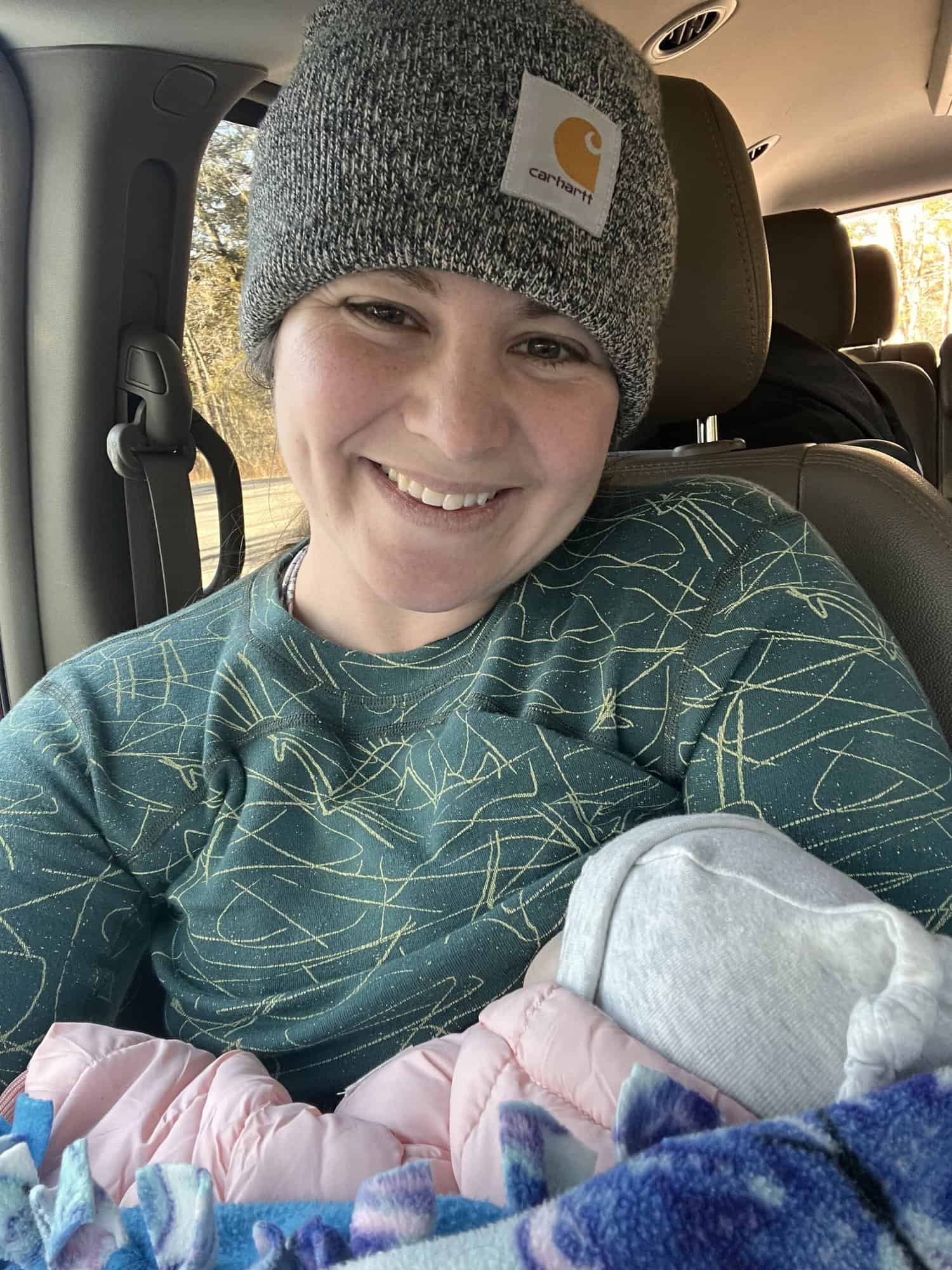
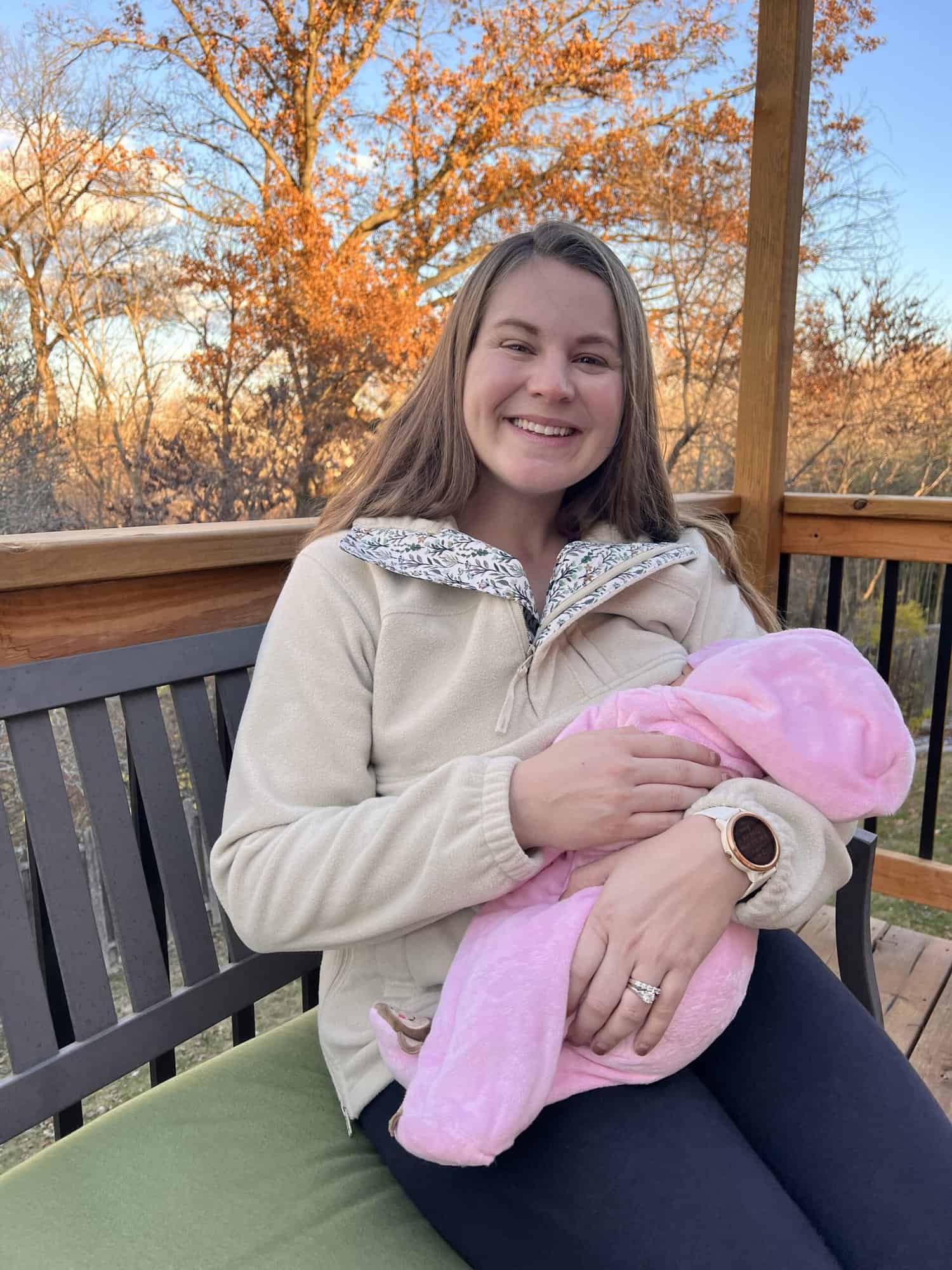
Tip 3: Start slow and easy
When you’re just getting back out into the world with a newborn, it’s best to start with short and easy hikes. Opting for shorter, more manageable trails is a great option for introducing your newborn to the joys of winter hiking without overwhelming them. These introductory outings provide an opportunity to acclimate both yourself and your little one to the challenges and delights of hiking in colder temperatures.
Your baby is new and your body is still recovering, so start with easy and short hikes that get you out of the house, but don’t overdo it. Pay close attention to your baby’s cues and comfort levels, especially in the early days of hiking with them.
Try to choose flat trails, that don’t require big steps or scrambling over rocks. This is easier on your body and allows you to gauge your baby’s comfort level, observe their reactions to the outdoor environment, and gradually build up both your confidence and stamina as a hiking duo. Shorter hikes minimize the risk of exhaustion or discomfort for both you and your little one.
Plus, choosing easy hikes ensures that you can focus more on bonding with your baby and soaking in the natural beauty around you, rather than feeling overwhelmed by the physical demands of a more strenuous trail. Because, at this phase, that’s what it’s all about! Save the longer hikes for when baby is older, when hiking with big kids, or when you’re hiking solo.
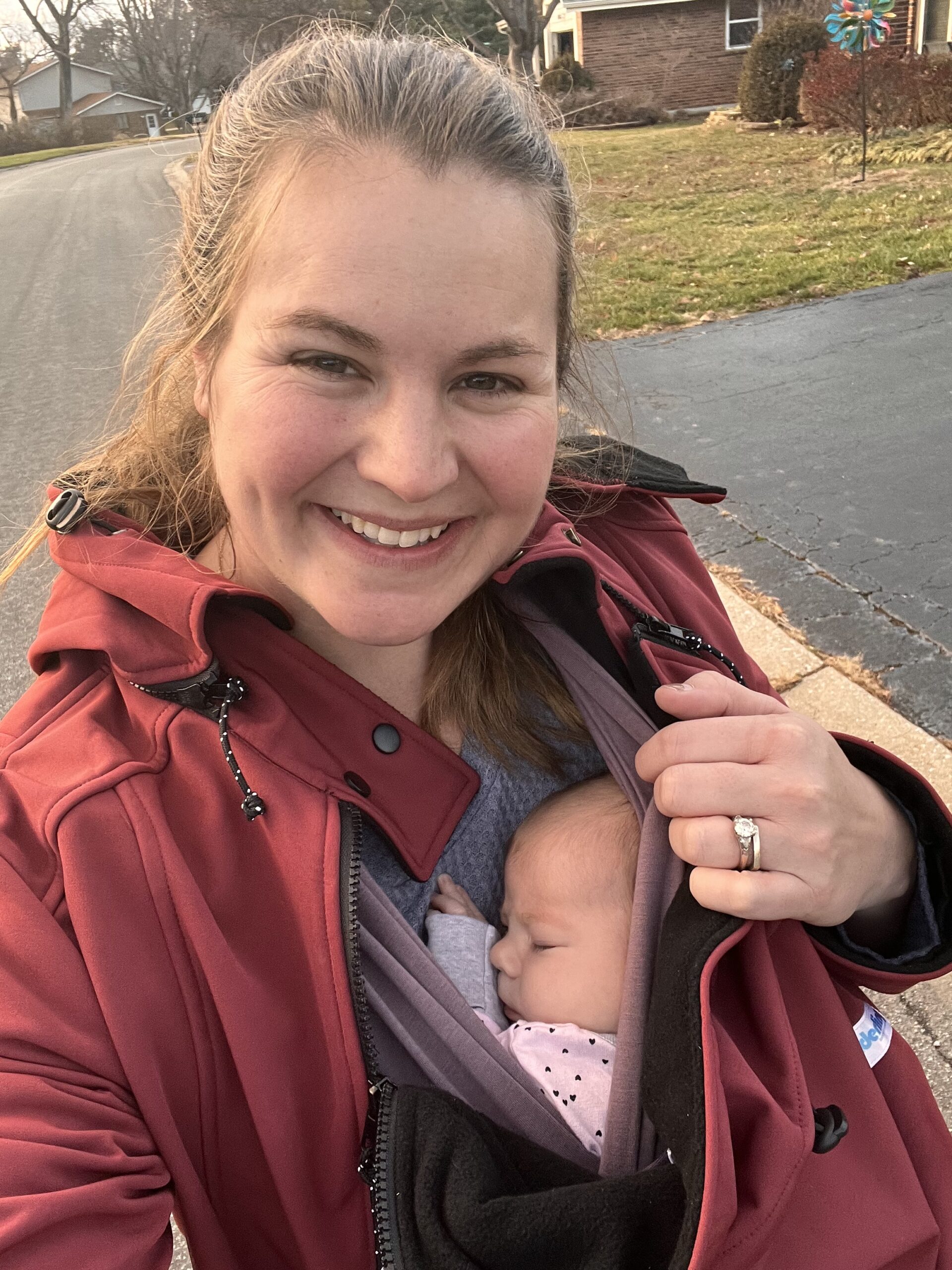
Tip 4: Time it right
Timing your hikes right when you have a newborn is important for an enjoyable experience. There’s nothing worse than spending all that time getting to your destination, only to have the timing be off. Luckily, newborns are pretty “go with the flow” and can nap and eat easily on the go.
The best times to go hiking with a newborn often coincide with their natural rhythms, including nap and feeding schedules. Opting for a hike during the warmest part of the day can help ensure your baby stays comfortable in chilly winter temperatures.
Many parents find that late morning or early afternoon hikes work well, as babies are often well-rested after their morning nap and have been fed, making them more content and less likely to become fussy during the hike. Consider your baby’s needs and preferences when scheduling your hikes. Some babies may be more alert and engaged in the outdoors in the morning, while others may enjoy the calming effects of nature in the late afternoon or early evening.
Whenever you go, be prepared for diaper changes and feedings along the way by packing what you need food and diaper-wise (bottles, formula, a portable changing mat, plenty of diapers and wipes, etc.) in your hiking backpack. Other important items to pack include first aid kit, rain cover, extra layers, extra water, trash bag (or plastic bag for dirty diapers/waste), smartphone, extra clothes (keep them in the car), and mittens/gloves.
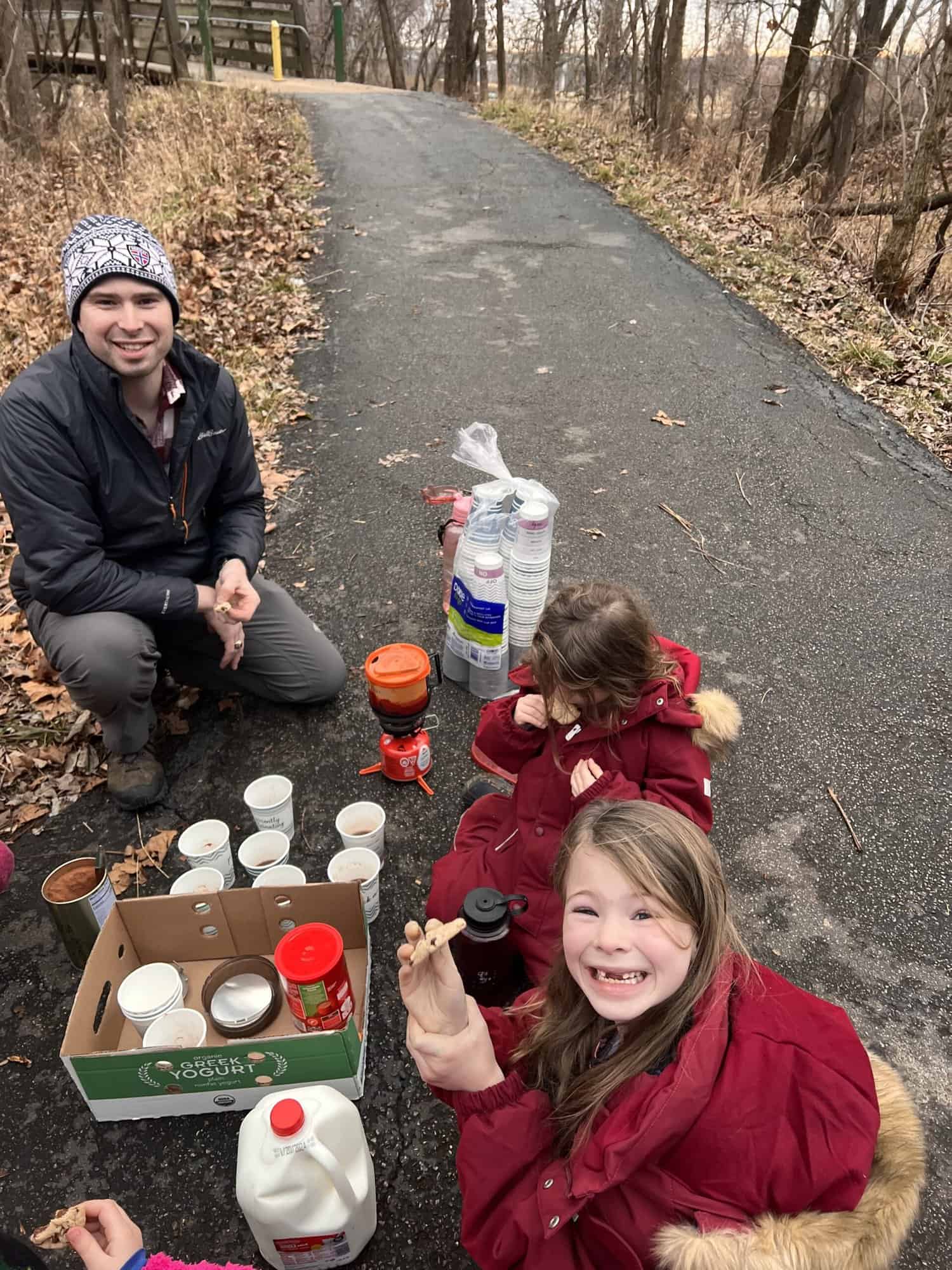
Tip 5: Stay hydrated and fueled
Anytime you’re out adventuring with kids, you’re going to need snacks and water. But, staying hydrated and nourished is crucial when hiking during the winter months, especially when you have a newborn and kids in tow.
Cold weather can actually increase the body’s need for hydration (even though you may not feel as thirsty), as dry air and physical activity can lead to increased fluid loss through respiration and sweat. Plus, if you’re nursing, you’ll need extra fluids to stay well hydrated.
Make sure you bring plenty of water for both you and your children on your hikes and encourage regular hydration breaks throughout the hike. Pack a water bottle for yourself and one for each of your little ones so you can monitor how much everyone is drinking during your winter hike. Additionally, packing hydrating snacks such as fruits, nuts, and granola bars can help replenish energy levels and maintain optimal hydration throughout the day.
For breastfeeding moms, staying hydrated is particularly important, as dehydration can affect milk production and quality. By prioritizing hydration and nourishment, you can ensure that both you and your children have the energy and stamina needed to enjoy your winter hiking adventures to the fullest.
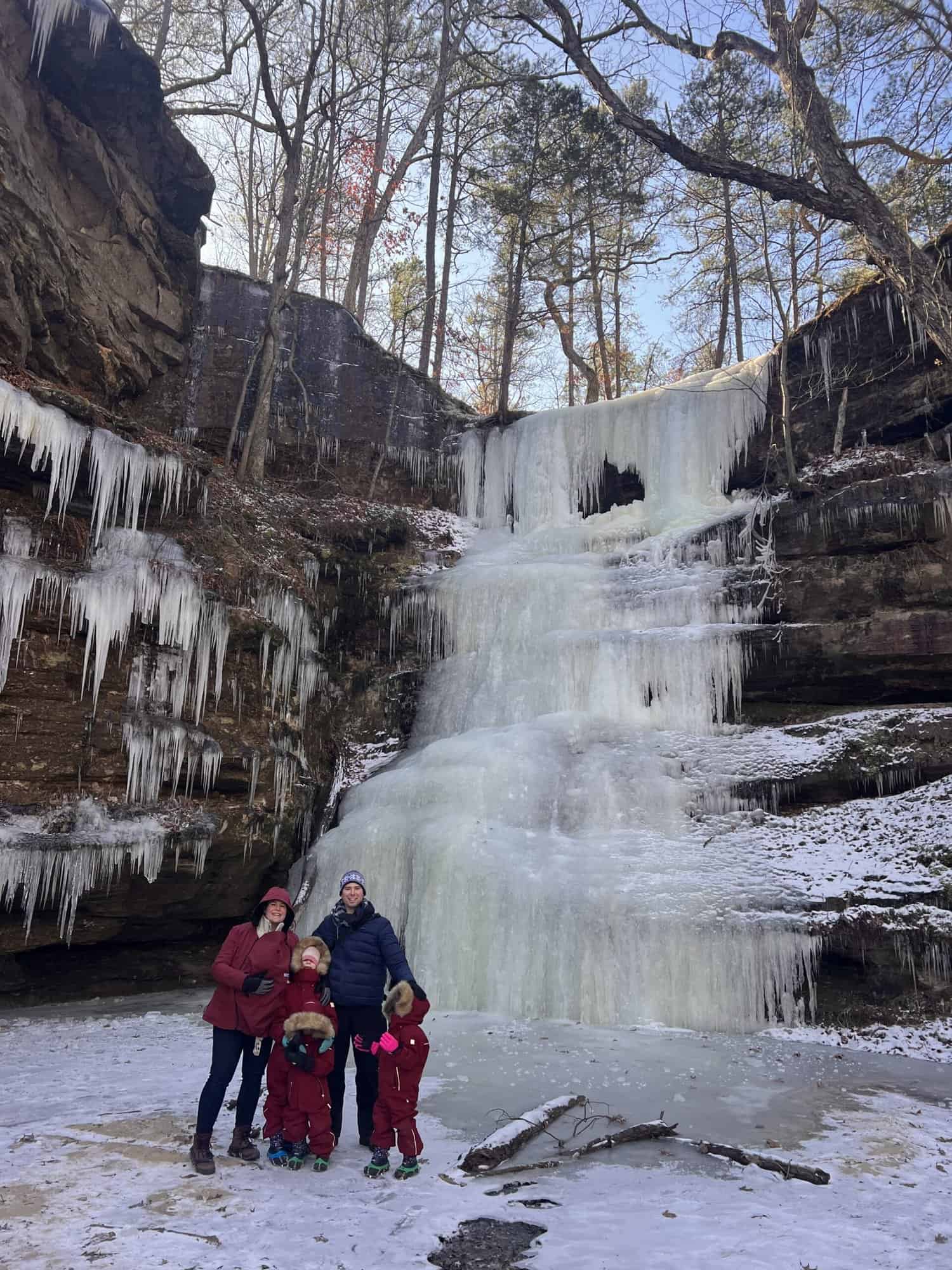
Winter hiking for the win
Winter is a beautiful time to explore outside as a family! While it can be chilly, getting fresh air and having a peaceful time together outside is worth it. Embarking on your baby’s first hike is a milestone worth celebrating, marking the beginning of many outdoor adventures to come.
One of our favorite winter activities is meeting friends at a trail for a hot chocolate hike! It is still possible to get outside with a baby and explore, even in the winter.
How do you get outside with a newborn during the winter months?
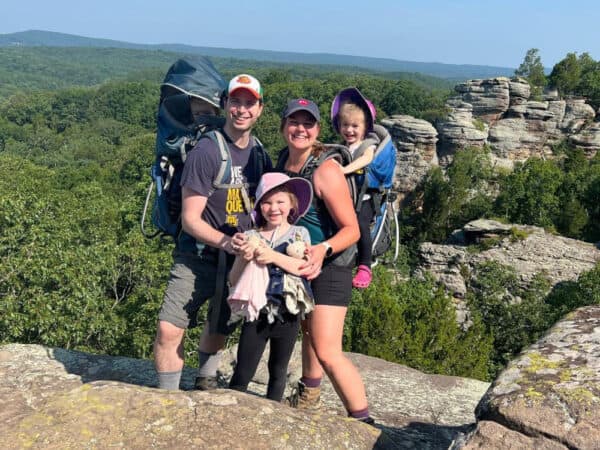
About the author
Steph lives in St. Louis with her husband, Mark, their four daughters (ages 6, 4, 2 & newborn), and their funny pup. Steph taught elementary school for five years and became a stay-at-home mom when her first child was born. When the pandemic hit and the playgrounds were closed, she started taking her kids hiking on a different trail each day. Steph is also a NICU mama (her 2nd daughter was born 3 months early). The outdoors has been so healing for her and her family, not to mention fun!
Since the pandemic started, their family has visited over 175 parks and hiked over 200 trails around St. Louis and Missouri. They also love to tent camp, canoe, and bike. Steph has a passion for exploring the outdoors, helping start a free weekly nature playgroup, and sharing adventure tips with others. When she is not hiking, she loves baking, reading, and dreaming of being a Survivor contestant.
You can find more from Steph in the following locations:
Instagram: @explorestlparks
RWMC posts: Steph Hampton







